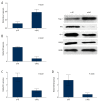Regulation of Keap-1/Nrf2 Signaling Pathway Is Activated by Oxidative Stress in Patients with Premature Rupture of Membranes
- PMID: 32589628
- PMCID: PMC7339974
- DOI: 10.12659/MSM.921757
Regulation of Keap-1/Nrf2 Signaling Pathway Is Activated by Oxidative Stress in Patients with Premature Rupture of Membranes
Abstract
BACKGROUND The potential mechanisms underlying premature rupture of membrane (PROM) is still unknown. The aim of this study was to determine the role of Keap-1/Nrf2 signaling pathway activation by oxidative stress in patients with preterm premature rupture of membranes. MATERIAL AND METHODS Placental tissues from preterm premature rupture of membranes (PPROM) (n=20), full-term premature rupture of membranes (FPROM) (n=20), and normal-term births (n=20) were collected and amniotic tissues were separated from the placental tissues from pregnant women at Shandong Provincial Qianfoshan Hospital. RT-PCR and Western blot were used to detect the levels of factors in the Keap-1/Nrf2 signaling pathway. To investigate the roles of Nrf2, we downregulated Nrf2 expression using siRNA in primary human amniotic epithelial (HAE) cells. RESULTS Among the control group, FPROM group, and PPROM group, the reactive oxygen species (ROS) levels were significantly increased in the FPROM and PPROM groups. The differences indicated higher levels of oxidative stress in amniotic tissues with FPROM and PPROM after downregulation of si-Nrf2 in HAE cells. Antioxidants were lower in amniotic tissues with the FPROM group and PPROM group than in the control group. The antioxidant enzymes catalase (CAT), glutathione (GSH), glutathione peroxidase (GSHPx), and superoxide dismutases (SOD1 and SOD2) were examined in amniotic tissues. We found that the ROS levels were significantly increased after downregulation of si-Nrf2 compared with the control group. We found that the expression of Heme Oxygenase-1 (HO-1) and Glycogen Synthase Kinase-3ß (GSK-3ß), which is critical in the Keap-1/Nrf2 signaling pathway, increased significantly after downregulation of si-Nrf2 in HAE cells. CONCLUSIONS We found that increased ROS levels and decreased antioxidant enzymes in the PPROM and FPROM patients compared with the control group.
Conflict of interest statement
None.
Figures




Similar articles
-
Mechanism of oxidative stress and Keap-1/Nrf2 signaling pathway in bronchopulmonary dysplasia.Medicine (Baltimore). 2020 Jun 26;99(26):e20433. doi: 10.1097/MD.0000000000020433. Medicine (Baltimore). 2020. PMID: 32590729 Free PMC article.
-
Oxidative stress damage-associated molecular signaling pathways differentiate spontaneous preterm birth and preterm premature rupture of the membranes.Mol Hum Reprod. 2016 Feb;22(2):143-57. doi: 10.1093/molehr/gav074. Epub 2015 Dec 21. Mol Hum Reprod. 2016. PMID: 26690900
-
Infection-induced thrombin production: a potential novel mechanism for preterm premature rupture of membranes (PPROM).Am J Obstet Gynecol. 2018 Jul;219(1):101.e1-101.e12. doi: 10.1016/j.ajog.2018.04.014. Epub 2018 Apr 13. Am J Obstet Gynecol. 2018. PMID: 29660299 Free PMC article.
-
Panaxatriol saponin ameliorates myocardial infarction-induced cardiac fibrosis by targeting Keap1/Nrf2 to regulate oxidative stress and inhibit cardiac-fibroblast activation and proliferation.Free Radic Biol Med. 2022 Sep;190:264-275. doi: 10.1016/j.freeradbiomed.2022.08.016. Epub 2022 Aug 14. Free Radic Biol Med. 2022. PMID: 35977659 Review.
-
Antioxidants for Early Treatment of Type 2 Diabetes in Rodents and Humans: Lost in Translation?Diabetes. 2024 May 1;73(5):653-658. doi: 10.2337/db23-0901. Diabetes. 2024. PMID: 38387049 Free PMC article. Review.
Cited by
-
Novel Insights into the Regulatory Role of Nuclear Factor (Erythroid-Derived 2)-Like 2 in Oxidative Stress and Inflammation of Human Fetal Membranes.Int J Mol Sci. 2020 Aug 26;21(17):6139. doi: 10.3390/ijms21176139. Int J Mol Sci. 2020. PMID: 32858866 Free PMC article.
-
Potential Serum Biomarkers Associated with Premature Rupture of Fetal Membranes in the First Trimester.Front Pharmacol. 2022 Jul 8;13:915935. doi: 10.3389/fphar.2022.915935. eCollection 2022. Front Pharmacol. 2022. PMID: 35873552 Free PMC article.
-
Development of a Novel Nomogram for Predicting Premature Rupture of Membrane in Pregnant Women With Vulvovaginal Candidiasis.Front Med (Lausanne). 2021 Nov 15;8:717978. doi: 10.3389/fmed.2021.717978. eCollection 2021. Front Med (Lausanne). 2021. PMID: 34869416 Free PMC article.
References
-
- Schmitz T, Sentilhes L, Lorthe E, et al. Preterm premature rupture of the membranes: Guidelines for clinical practice from the French College of Gynaecologists and Obstetricians (CNGOF) Eur J Obstet Gynecol Reprod Biol. 2019;236:1–6. - PubMed
-
- Weiner E, Barrett J, Zaltz A, et al. Amniotic fluid volume at presentation with early preterm premature rupture of the membranes and the association with severe neonatal respiratory morbidity. Ultrasound Obstet Gynecol. 2019;54(6):767–73. - PubMed
-
- Dagklis T, Petousis S, Margioula-Siarkou C, et al. Parameters affecting latency period in PPROM cases: A 10-year experience of a single institution. J Matern Fetal Neonatal Med. 2013;26:1455–58. - PubMed
-
- Polettini J, Dutta EH, Behnia F, et al. Aging of intrauterine tissues in spontaneous preterm birth and preterm premature rupture of the membranes: A systematic review of the literature. Placenta. 2015;36:969–73. - PubMed
MeSH terms
Substances
Supplementary concepts
LinkOut - more resources
Full Text Sources
Miscellaneous

